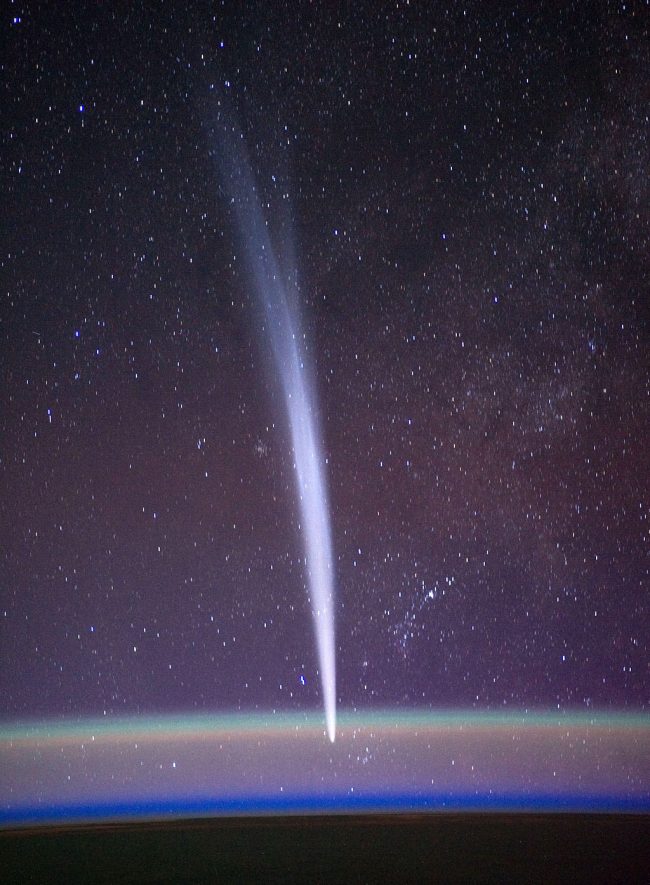

That no terrestrial consequences were detected is not surprising when we learn that 2000 cubic miles of the tail contained less material than a single cubic inch of ordinary air. The thin vacuous tail caused no observable effect on earth, except for such human aberrations as the spirited sale of asbestos suits. Later in May, the earth grazed the edge of the tail. During the early part of May it increased until the brilliance of its head equaled the brightest stars and its tail extended sixty degrees across the sky. On its latest return, in 1910, Halley’s comet put on a magnificent display, reaching its climax several weeks after perihelion passage in mid-April.

Although he was ridiculed for setting the date beyond his expected lifetime, the comet indeed returned, and Halley’s name has been linked with it ever since. Assuming these to be different appearances of the same celestial object, he predicted another return in 1758. Halley had matched the Comet of 1682, which he had observed, with those of 15. It was the first to have a periodic orbit assigned, thus securing for comets their place as members of the solar system. The Comet of 1577 completely shattered the immutable crystalline spheres, thereby contributing to the breakdown of Aristotelian physics and the acceptance of the Copernican system.īut the most renowned and most thoroughly studied of all comets is the one associated with Edmund Halley. Tycho, by comparing his careful measurements of the comet’s position with data from distant observers, proved that it sped through space far beyond the moon. In 1577 most astronomers still subscribed to the ancient belief that the moon and planets were carried around the earth on concentric shells of purest ether. Or, if not that, they were burning impurities on the lower fringe of the celestial ether, far below the orbit of the moon.

In the sixteenth century nearly everyone accepted Aristotle’s idea that comets were meteorological phenomena, fiery condensations in the upper atmosphere. Tycho’s precise observations over the ten-week span before the comet faded away were to deal the deathblow to ancient cosmogonies and pave the way for modern astronomy.

As darkness fell, a splendid twenty-two-degree tail revealed itself. The celebrated Danish astronomer Tycho Brahe was among the early observers: he caught sight of the brilliant nucleus while he was fishing, even before the sun had set. Discovered in November of that year, the comet stood like a bent red flame in the western sky just after sunset. Team Sound includes: Tate Abdullah, Emily Brunner, Peter Burns, Bridget Doherty, Chris Evans, David Gotwald, J.D.OF ALL the memorable comets that have excited astronomers and stirred men’s imaginations, not one had more impact on our concepts of the universe than the Great Comet of 1577. Kulickĭrapers: Noelle Cremer, Ana Cobos, Ayelet Birmanįirst Hands: Ayelet Birman, Elyse Grimaldi, Moire Diaz, Clio Gordon, Matthew Torbett, Danielle Dulchinos, Kendall SwendsenĬostume Painters: Miranda Boodheshwar, Yafei Hu, Janelle Mosovsky (Lead), Cecilia ShinĪssistant Production Manager: Kaylie CarpenterĪssistant Stage Managers: Keen Ma, Gabby FonescaĪssistant Costume Designers: Miranda Boodheshwar, Grace Kang, Grzegorz LabudaĪssistant Lighting Designer: Sasha FinleyĢ nd Assistant Lighting Designer: Eva OneyĪssistant Lighting Manager: Ariel Bernhard Natasha: Riley Noland ( April 15 th, 17 th 2pm, 20 th, 22 nd, 23 rd 8pm)Ĭhorus: Chloe Brown, Brayden Co, Olivia de Waart, Annabelle Duffy, Amanda Ju, Betsy Miller, Kevin Tappan Jr., Gerardo Navarro Natasha: Rayven Bailey ( April 16 th, 17 th 8pm, 19 th, 21 st, 23 rd 2pm) Pierre: Henry Thrasher ( April 16 th, 17 th 8pm, 20 th, 21 st, 23 rd 2pm) Pierre: Laughton Royce ( April 15 th, 17 th 2pm, 19 th, 22 nd, and 23 rd 8pm)


 0 kommentar(er)
0 kommentar(er)
